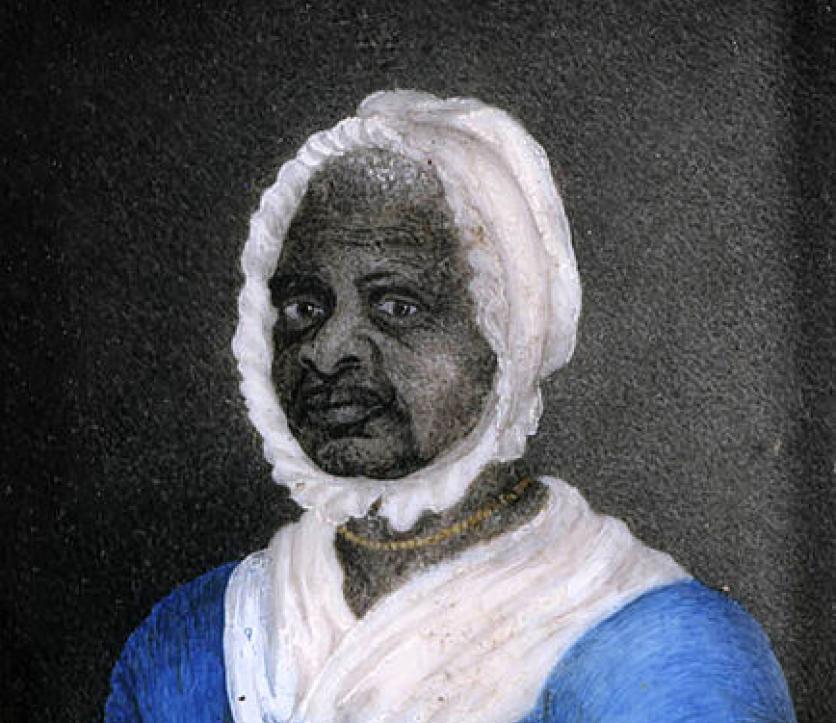Freedom Suit Petitioner
By Katie Woods, Digital Public Historian
Living approximately thirty years in slavery, Elizabeth Freeman (also known as “Mum Bett,” her name while enslaved) successfully filed and won a freedom suit (a court case that argued for her freedom) in Massachusetts, helping set a legal precedent for abolishing slavery in the Commonwealth in 1783.
Any time, any time while I was a slave, if one minute’s freedom had been offered to me, and I had been told I must die at the end of that minute, I would have taken it–just to stand one minute on God’s airth [sic] a free woman – I would.”
Born in Claverack, New York around 1744, Freeman was originally enslaved by Pieter Hogeboom. While young, she and her sister, Lizzy, were gifted to Hogeboom’s daughter Hannah and her husband Colonel John Ashley of Sheffield, Massachusetts, a judge of the Berkshire Court of Common Pleas.
Details of her life while enslaved in Sheffield are limited. At some point, Freeman had a daughter, and some sources suggest she had a husband who died during the Revolutionary War. Due to her status, Freeman did not know how to read or write. One of the most repeated stories is that of an incident between her and Hannah Ashley. When Mrs. Ashley attempted to beat Lizzy, Freeman put herself in front of her sister, receiving a life-long injury to her arm.
There are several theories as to how Freeman’s desire to obtain freedom turned into action. According to acquaintance Catherine Sedgwick, a famed novelist who also wrote of Freeman’s life, Freeman considered the potential of obtaining her freedom after hearing a reading of the Declaration of Independence. She wondered why elements of the Declaration, such as “all men are created equal” and all should have access to “life, liberty and the pursuit of happiness,” did not apply to her. A different account suggests Freeman heard discussions of freedom and equality from John Ashley and his colleagues at his home. These men likely discussed the 1773 Sheffield Declaration–a local precursor to the Declaration of Independence–as well as the Declaration of Independence and the Massachusetts Constitution. Yet another version indicates Freeman immediately fled the Ashley household following Hannah Ashley’s attack.
Regardless of what ultimately prompted her to take action, Freeman felt deserving of the same rights – freedom and equality, specifically–as others. In May 1781 Freeman sought the assistance of abolitionist and attorney Theodore Sedgwick (Catherine’s father) in nearby Stockbridge. Sedgwick took her case and filed a “writ of replevin” on behalf of Freeman (under her enslaved name, “Mum Bett”) and an enslaved man named Brom. This writ stated that John Ashley had unlawfully obtained property (Bett and Brom) and that he had to return them to the local sheriff; in other words, he had to free them. John Ashley refused to comply.
Brom and Bett v. John Ashley advanced to the Great Barrington County Court, where a trial occurred in August 1781. On August 22, the jury sided with Bett and Brom, granting them their freedom and directing Ashley to pay them each 30 shillings and their court fees. This case provided legal precedent for other freedom suits, leading to the abolition of slavery in the Commonwealth in 1783.
Following her emancipation, Mum Bett chose the name “Elizabeth Freeman.” Although John Ashley offered to hire Freeman as a paid servant, she decided to work as a paid domestic worker for the Sedgwick family. Freeman also became a respected healer, nurse, and midwife.
In 1808, Freeman and her daughter bought their own house in Stockbridge. Freeman lived here until she passed away on December 28, 1829 at around 85 years old.
She is buried in the Sedgwick family plot in Stockbridge. While her gravestone does not mention the significant contribution she made to end slavery in Massachusetts, it does provide insight into the woman behind the court case: “She was born a slave and remained a slave for nearly thirty years. She could neither read nor write, yet in her own sphere she had no superior or equal.”
Additional Resources
“1781: Mum Bett Challenges Slavery.” Long Road to Justice. 2023. Accessed November 2023.
“The Legal End of Slavery in Massachusetts.” Massachusetts Historical Society. Accessed November 2023.
“The story of Elizabeth Freeman and how slavery ended in Massachusetts.” WGBH. Last Modified August 28, 2023.
Bibliography
Alexander, Kerri Lee. “Elizabeth Freeman.” National Women’s History Museum. 2019. Accessed November 2023.
“Elizabeth Freeman, Illiterate Slave, Wins Freedom and Honor.” New England Historical Society. Last Modified 2023. Accessed November 2023.
Feldman, Ella. “How an Enslaved Woman Took Her Freedom to Court.” Smithsonian Magazine. August 29, 2022. Accessed November 2023.
“Jury Decides in Favor of Elizabeth ‘Mum Bett’ Freeman.” Mass Moments. Mass Humanities. Accessed November 2023.
Massachusetts Court System. “Massachusetts Constitution and the Abolition of Slavery.” Mass.gov. Accessed November 2023.
Sedgwick, Catherine. “Slavery in New England.” In Bentley’s Miscellany vol. 34, 417-424. London: Richard Bently, 1834. Accessed November 2023.
